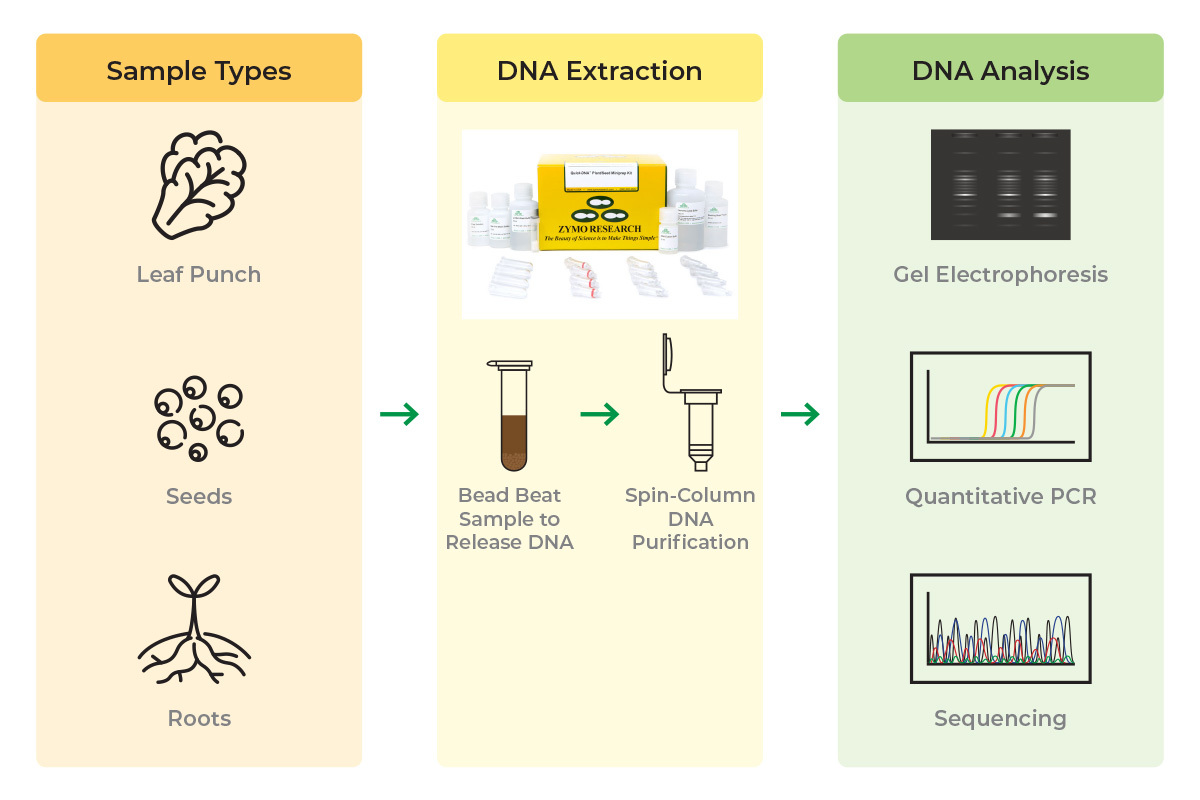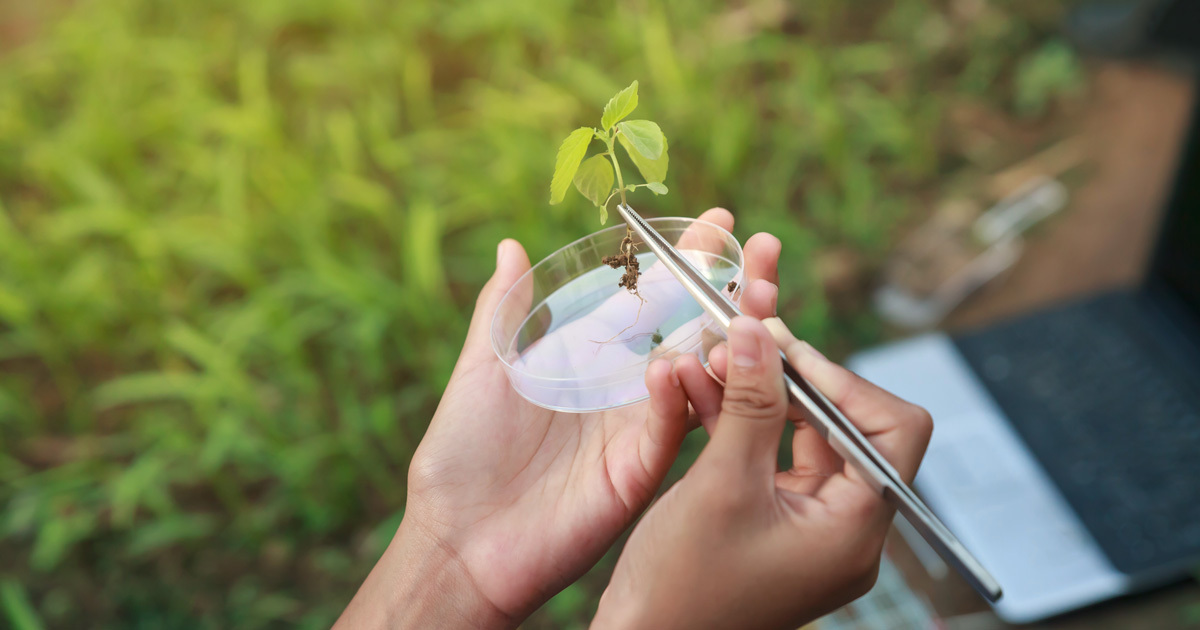Listen to the blog
Modern genomics techniques have promised to revolutionize plant biology, generating data to accelerate crop improvement, optimize plant selection, and advance our basic understanding of plant biology.1 Such techniques and applications rely on the extraction of high-quality DNA from a variety of distinct plant species and sample types.
To keep up with this rapidly advancing field, plant DNA extraction protocols must be robust, flexible, consistent, and fast. But plant tissues pose several challenges for even the most tried-and-true DNA extraction protocols. Plant cell walls are very difficult to break down and the cells contain many compounds that impede extraction and inhibit downstream molecular biology applications.
The CTAB Method: DNA Extraction from Plant Leaves and Seeds
To overcome the challenges presented by plant tissues, the cetyltrimethylammonium bromide (CTAB) method has become the “go-to” protocol for DNA extraction and purification from leaves and seeds. It was developed in the 1980s and has been used ever since, with various modifications for different plant species.2-5
In the CTAB DNA extraction protocol, the first step is breaking down the tissue, and it involves freezing your plant sample using liquid nitrogen. Once the tissue has been frozen, it is ground into a fine powder with a mortar and pestle or a blender. After grinding, the tissue is transferred to a tube and CTAB buffer is added. CTAB buffer is a cationic detergent that facilitates cell lysis and prevents secondary metabolites from interfering with DNA extraction.
Following plant cell lysis, RNase A is added to digest RNA, and DNA is separated from other cellular components using phenol/chloroform extraction, which separates the sample into two distinct aqueous and organic phases after centrifugation. Nonpolar molecules migrate into the organic phase and leave behind DNA and other polar molecules in the aqueous phase. The extraction is repeated on the aqueous phase until it becomes completely clear and all DNA is collected. The aqueous phase is collected, and the recovered DNA is precipitated out with isopropanol. The precipitate is pelleted by centrifugation and washed with 70% ethanol to remove salts introduced during extraction. Once the ethanol is decanted, the residual ethanol in the pellet is evaporated away and the dried pellet is resuspended in your buffer-of-choice for your downstream application, such as PCR or NGS.
Considerations Before Performing CTAB DNA Extraction
CTAB buffer-based extraction methods are biochemically simple, easy to learn, and relatively cheap to perform. However, in practice, the protocol has several drawbacks: it is lengthy, tedious, and low throughput, with many steps that require careful handling, exposure to hazardous chemicals, and several other technical considerations. Included are some important considerations to keep in mind before performing a CTAB DNA extraction.
Timing Your DNA ExtractionsFrom grinding with a mortar and pestle to resuspending sticky DNA pellets, the full CTAB protocol can take approximately two hours to process a small number of samples. There are also more than twenty steps in the protocol and as the number of samples increases, the amount of time needed to complete DNA extraction increases substantially. Plan your day carefully and set aside the proper amount of time to complete the entire protocol.
Working With Hazardous MaterialsCaution must be taken when working with liquid nitrogen for the first grinding step as it can rapidly freeze skin tissue and cause cold burns even with short exposure. In addition, working with phenol and chloroform is a biosafety hazard: Phenol can cause chemical burns and chloroform is a potential carcinogen.6,7 For many food testing labs, the use of these toxic chemicals is a major concern. The use of phenol and chloroform also generates organic waste which requires special storage containers and disposal procedures. Be sure you have the proper safety protocols in place before starting your CTAB DNA extractions.
Processing the Plant TissueTissue grinding can vary between samples, leading to significant variation in extraction efficiencies and quality of DNA. To achieve more consistent tissue disruption across samples, you can also use a blender, though this step is still low throughput and time consuming. The more finely your tissue is ground, the more efficient your DNA extraction will be, making this a critical step for successful CTAB DNA extraction.
Phase SeparationA solution of phenol/chloroform/isoamyl alcohol is used to extract plant DNA from cellular debris and once added and vortexed, the mixture separates into three distinct phases: aqueous, interphase, and organic phase with the aqueous phase containing the isolated DNA. Although removing the aqueous phase and repeating the extraction is time consuming and laborious, it is highly recommended to maximize DNA quality. Failure to separate the aqueous phase out properly may leave DNA behind or carry over contaminants from the interphase and organic phase, lowering your overall DNA yield and quality.
PCR InhibitorsSeveral classes of biochemicals found in plant tissues, including polysaccharides, lipids, polyphenols, and/or other secondary metabolites, can coprecipitate with DNA and inhibit downstream applications that rely on thermostable DNA polymerases, such as PCR. The structure and concentration of these compounds can vary substantially between different plant species, making the development and optimization of a “one size fits all” CTAB protocol difficult.8,9 In addition, phenol and other salts introduced throughout your CTAB protocol can remain, even after extensive ethanol washes. These impurities can also interfere with downstream applications, including PCR and NGS.10 Zymo Research’s OneStep PCR Inhibitor Removal Kits are specifically designed for the efficient removal of PCR inhibitors from even the most impure preparations, all in a simple one-step procedure. Plan accordingly to ensure your recovered plant DNA will be suitable for any intended downstream application.
An Alternative Method for Isolation of DNA from Plant Tissues
If that all seems like a bit much, we empathize and couldn’t agree more. Fortunately, there are plant-specific DNA isolation kits that provide faster, more consistent, high-purity DNA extraction than the conventional CTAB protocols without the need for hazardous chemicals. These are essential for maintaining and further supporting the rapidly evolving pace, scope, and scale of agricultural R&D.
Zymo Research’s Quick-DNA Plant/Seed Kits use bead beating and column-based purification to provide a simple, rapid workflow for the isolation of inhibitor-free DNA from a variety of plant sources (Figure 1). There are no repetitive and lengthy phase separation steps or hazardous reagents used, so you can further streamline your lab’s operations and protect the safety of key personnel. You can also skip the lengthy RNase digestion step, incubations and centrifugations, and precipitation steps.

The DNA extraction protocol can be completed in as little as 15 minutes and will give you a straightforward path to high-quality DNA. If you’re working with a challenging plant species, such as cacao and cannabis, try out our state-of-the-art BashingBeads for more complete lysis and more consistent yields (Figure 2).11-14

Our binding chemistry, wash solutions, and spin column technology remove polysaccharides, lipids, and other common downstream inhibitors and contaminants providing ultra-pure DNA, with minimal loss. Furthermore, our protocol has been optimized to work with a wide range of plant species and sample types, enabling novel and rapid advancements in modern plant genomics. See how we can help you rapidly and efficiently extract high-quality plant DNA.
Citations
- Genomics Era for Plants and Crop Species – Advances Made and Needed Tasks Ahead. IntechOpen website: https://www.intechopen.com/chapters/49877. Published July 14th, 2016. Accessed October 27th, 2021.
- Doyle J, Doyle J. A Rapid DNA Isolation Procedure for Small Quantities of Fresh Leaf Tissue. Phytochem Bull. 1987;19(1):11-15.
- Murray MG and Thompson WF. Rapid isolation of high molecular weight plant DNA. Nucleic acids research. 1980; 8(19); 4321–4325. https://doi.org/10.1093/nar/8.19.4321
- Aboul-Maaty NAF, Oraby HAS. Extraction of high-quality genomic DNA from different plant orders applying a modified CTAB-based method. Bull Natl Res Cent. 2019;43(25). doi.org/10.1186/s42269-019-0066-1
- Muhammad I, Zhang T, Wang Y, et al. Modification of CTAB protocol for maize. Res J Biotech. 2013;8:41–45.
- 22. Safe Use of Phenol | Safety Services. UC - Davis Safety Services website: https://safetyservices.ucdavis.edu/safetynet/safe-use-of-phenol. Published March 26th, 2020. Accessed October 27th, 2021.
- Report on Carcinogens, Fourteenth Edition. National Toxicology Program website: https://ntp.niehs.nih.gov/ntp/roc/content/profiles/chloroform.pdf. Published November 3rd, 2016. Accessed October 27, 2021.
- Aboul-Maaty NAF, Oraby HAS. Extraction of high-quality genomic DNA from different plant orders applying a modified CTAB-based method. Bull Natl Res Cent. 2019;43(25). doi.org/10.1186/s42269-019-0066-1
- CTAB Protocol for the Isolation of DNA from Plant Tissues. OPS Diagnostics website: https://opsdiagnostics.com/notes/protocols/ctab_protocol_for_plants.htm. Accessed October 27, 2021.
- Angeles JGC, Laurena AC, Tecson-Mendoza EM. Extraction of genomic DNA from the lipid-, polysaccharide-, and polyphenol-rich coconut (Cocos nucifera L.). Plant Mol Biol Report. 2012;23(3):297-298. doi:10.1007/BF02772760
- Kamber T, Malpica-López N, Messmer MM, et al. A qPCR Assay for the Fast Detection and Quantification of Colletotrichum lupini. Plants. 2021;10(8):1548. doi:10.3390/PLANTS10081548
- Romero Navarro JA, Phillips-Mora W, Arciniegas-Leal A, et al. Application of Genome Wide Association and Genomic Prediction for Improvement of Cacao Productivity and Resistance to Black and Frosty Pod Diseases. Front Plant Sci. 2017;8:1905. doi:10.3389/fpls.2017.01905
- Cornejo OE, Yee MC, Dominguez V, et al. Population genomic analyses of the chocolate tree, Theobroma cacao L., provide insights into its domestication process. Commun Biol. 2018;1:167. doi:10.1038/s42003-018-0168-6
- Garfinkel AR, Otten M, Crawford S. SNP in Potentially Defunct Tetrahydrocannabinolic Acid Synthase Is a Marker for Cannabigerolic Acid Dominance in Cannabis sativa L. Genes. 2021;12(2):228. doi:10.3390/GENES12020228
